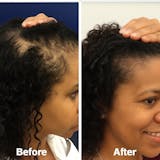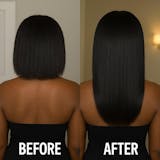Caffeine for Hair Growth: The Secret Ingredient You’re Missing
Caffeine for Hair Growth: The Secret Ingredient You’re Missing
For most people, caffeine is the ingredient that fuels mornings and keeps energy levels steady throughout the day. But in recent years, researchers and beauty experts have discovered that caffeine has another powerful benefit: it can help support hair growth. Far beyond just being your go-to drink, caffeine has become one of the most promising natural hair growth ingredients, showing results in reducing shedding, improving follicle activity, and prolonging the growth phase of the hair cycle.
The beauty industry has started embracing this research, and now you’ll find caffeine in shampoos, conditioners, scalp serums, and caffeine-infused oils. At Seddy Naturals, we have incorporated caffeine into our Hair Growth Oil because it works in synergy with rosemary, peppermint, castor, and argan oil to stimulate the scalp, protect follicles, and improve overall hair health.
In this guide, we’ll explore why caffeine works for hair growth, what the science says, how to use it effectively, and how it compares to other natural remedies like rosemary oil, peppermint oil, and castor oil.
Why Caffeine Works for Hair Growth
Hair growth happens in cycles, with each strand of hair moving through three phases: anagen (growth), catagen (transition), and telogen (resting/shedding). The longer your hair stays in the anagen phase, the longer and fuller it grows. Unfortunately, hormones like dihydrotestosterone (DHT) can shorten this cycle, causing hair to thin and fall out sooner than it should.
This is where caffeine comes in. Applied topically to the scalp, caffeine penetrates the hair follicles and blocks the negative effects of DHT, helping to prolong the growth phase and encourage thicker, denser hair. In addition, caffeine increases blood circulation to the scalp, ensuring that follicles receive a steady supply of oxygen and nutrients.
Caffeine is also packed with antioxidants that protect the scalp and follicles from oxidative stress — one of the biggest causes of premature shedding. Unlike some harsh chemical treatments, caffeine is a gentle, natural solution that works for men and women, across all hair textures, including wavy, curly, and coily hair.

What Science Says About Caffeine for Hair Growth
Unlike many so-called miracle ingredients, caffeine is actually supported by clinical studies.
A 2007 study published in the International Journal of Dermatology found that caffeine stimulated hair follicles in both men and women suffering from androgenetic alopecia, commonly known as pattern baldness. Researchers discovered that caffeine could counteract the effects of testosterone-related hair loss by blocking DHT at the follicle level.
Another 2014 clinical trial confirmed that caffeine-based topical solutions encouraged significant hair growth compared to untreated scalp areas. More recent laboratory findings suggest that caffeine not only stimulates follicle activity but also prolongs the lifespan of hair cells and strengthens the root, making each strand more resilient to breakage.
The key takeaway? Drinking coffee isn’t enough — caffeine needs to be applied directly to the scalp in the form of oils, shampoos, or serums for maximum effect.
How Caffeine Helps with Thinning Edges and Hair Loss
One of the most common struggles people face is thinning edges, often caused by traction alopecia (tight hairstyles), postpartum shedding, or stress. Because the hairline is delicate, it’s one of the first places to show signs of damage. Caffeine oils are particularly helpful here, as they deliver direct stimulation to dormant follicles. Regular scalp massages with a caffeine-infused oil can gradually thicken edges and restore density.
Caffeine is also useful for people experiencing early signs of alopecia. By blocking DHT and stimulating follicle activity, caffeine helps slow down the progression of shedding and supports regrowth in areas where follicles are still alive. For individuals dealing with stress-induced shedding or postpartum hair loss, caffeine can accelerate recovery by improving circulation and supplying energy to the follicles during their rebuilding phase.

How to Use Caffeine for Hair Growth
Using caffeine effectively means consistency and proper application. Here are the best ways to incorporate caffeine into your hair routine:
1. Scalp Massage with Caffeine Oil
The simplest and most effective method is massaging caffeine-infused oil into the scalp. This not only delivers caffeine directly to the follicles but also boosts circulation through physical stimulation. Massage your scalp for 5–10 minutes, 3–4 times a week, focusing on areas prone to thinning such as the edges, crown, and temples.
2. Pre-Wash Oil Treatment
Applying caffeine oil before shampooing protects strands from dryness and ensures the scalp is nourished during cleansing. Leave it on for at least 30 minutes before washing, or overnight for maximum penetration.
3. Leave-In Application
Lightweight caffeine oils can also be applied after washing, directly to damp scalp and hair. This method works best for people with curly and coily textures who benefit from layering products to lock in moisture.
4. Hot Oil Treatments
For extra nourishment, warm a caffeine oil blend (such as Seddy Hair Growth Oil) and apply generously to your scalp and strands. Cover with a shower cap and allow the oil to penetrate for 20–30 minutes before rinsing. This is especially effective for dry, coily, or chemically treated hair.
Caffeine Hair Care Routines by Hair Type
Because every curl pattern has unique needs, caffeine should be used differently depending on your texture.
Wavy Hair (Type 2)
Wavy hair can become easily weighed down by heavy oils. Use caffeine oils sparingly, focusing on scalp massage rather than applying large amounts to the strands. Pair with lightweight oils like avocado or almond to maintain bounce and definition.
Curly Hair (Type 3)
Curly hair often needs more hydration and frizz control. Apply caffeine oil during pre-poo and massage into the scalp weekly. Pair with moisturizing leave-ins and medium-weight oils like argan to balance hydration and strength.
Coily Hair (Type 4)
Coily hair is most prone to dryness and shrinkage, making caffeine oils especially useful for scalp stimulation. Mix caffeine oil with heavier sealants like Jamaican Black Castor Oil for hot oil treatments. Focus on protective styling and consistent scalp massages to maximize growth.
Caffeine vs. Other Popular Hair Growth Ingredients
It’s important to understand how caffeine compares to other natural growth boosters:
-
Caffeine vs. Rosemary Oil: Both stimulate growth, but caffeine focuses more on blocking DHT, while rosemary increases circulation. Together, they form a powerful growth duo.
-
Caffeine vs. Castor Oil: Castor oil seals and strengthens, while caffeine energizes follicles and extends the growth phase.
-
Caffeine vs. Peppermint Oil: Both stimulate circulation, but peppermint offers cooling relief for itchy scalp, while caffeine directly supports follicle activity.
-
Caffeine vs. Coconut Oil: Coconut protects against protein loss but doesn’t stimulate growth like caffeine does.
The bottom line: caffeine works best in blends. That’s why Seddy Hair Growth Oil includes caffeine along with rosemary, peppermint, castor, and argan — to address multiple needs in one formula.
Your Growth. Our Mission -The Seddy Way
Common Mistakes When Using Caffeine for Hair
While caffeine is powerful, many people make mistakes that limit results. Applying caffeine oil once and expecting overnight growth won’t work. Consistency is key — most people see noticeable results in 3–6 months. Another mistake is applying too much oil, which can clog follicles and leave hair greasy. Always dilute caffeine essential oil with carrier oils if using it in DIY form, and avoid overloading fine hair.
Finally, some people think drinking coffee will replace topical caffeine — it won’t. Caffeine needs to be absorbed directly through the scalp for follicle stimulation.
Final Thoughts
Caffeine isn’t just your morning boost — it’s a science-backed, natural solution for hair growth. By stimulating follicles, blocking DHT, and improving scalp circulation, caffeine helps reduce shedding, thicken hair, and restore thinning areas like edges and crown.
When used consistently, caffeine oil is a powerful addition to any natural hair routine. And when blended with complementary oils like rosemary, peppermint, and castor, it becomes even more effective.
✨ Ready to try it? Explore the Seddy Naturals Hair Growth Collection — infused with caffeine, rosemary, peppermint, castor, and argan oils — to support your healthiest, fullest hair yet.

FAQs About Caffeine for Hair Growth
Q1: Does caffeine really make hair grow faster?
Caffeine doesn’t speed up your body’s natural growth rate, but it helps hair grow thicker, longer, and stronger by prolonging the growth phase and reducing shedding.
Q2: How often should I apply caffeine oil?
For best results, use 3–4 times per week through scalp massages or pre-wash treatments.
Q3: Can men use caffeine oils for hair loss?
Yes. Caffeine is particularly effective for early male pattern thinning, as it helps block DHT at the follicle level.
Q4: How long before I see results?
Most people notice reduced shedding within 6–8 weeks, with visible regrowth around 3–6 months.
Q5: Can caffeine regrow bald spots?
It can stimulate dormant follicles. If follicles are permanently scarred or dead, results may be limited.
Q6: Can caffeine be combined with other oils?
Yes. It pairs especially well with rosemary, peppermint, and castor oil for a complete growth blend.












